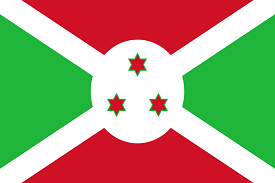Highlights

Flag
Origin:
The original national flag of Burundi (Kirundi: ibendera ry’Uburundi) was adopted after the country’s independence from Belgium on 1 July 1962. The flag consists of a white saltire which divides the field into alternating red and green areas. The center of the saltire merges into a white disk, on which there are three red solid six-pointed stars outlined in green. The current ratio is 3:5, which was changed from 2:3 on 27 September 1982.
Symbolism:
The flag is divided into four parts by a white saltire. The upper and lower parts are red in color, while the left and right ones are green in color. White color of the saltire represents peace, green represents the nation’s hopes placed on future development and red symbolizes the suffering of the nation during its freedom struggle. The three stars in triangular configuration stand for the three major ethnic groups of Burundi: the Hutu, the Twa and the Tutsi. The three stars also stand for the three elements of the national motto: Unité, Travail, Progrès (“Unity, Work and Progress”), which also represent loyalty to God, king and country.
History:
When the monarchy ruled over Burundi a variant flag featuring a karyenda (a drum said to have divine power) was used. it was believed that the drum’s messages could be understood only by the mwami (rulers) who made it the laws of the state. Following the abolition of the monarchy in November 1966, the karyenda was removed from the flag and the other flag was adopted soon after. The karyenda was replaced with a sorghum plant which is an important agricultural product of the country.
Population
Population 11.18 million as of 2018 . The Comprise of the Twa, Hutu and Tutsi peoples who have lived in that country for over 500 years.
Culture
Cultural highlights. Burundi is known as “ The Heart of Africa” because of its shape and location within the continent. Hospitality was once very important in Burundi. In the past, when people went on a journey, they would stop when they were tired or when night fell at any home.
Announcements
Famous People
Mwambutsa IV Bangiricenge – Circa 1912 – 1977. He was the penultimate (last) king of Burundi (mwawi) who ruled between 1915 and 1966. He succeeded to the throne on the death of his father Mutaga IV Mbikije (ruled 1908 – 1915). Born while Burundi was under German colonial rule, Mwambutsa’s reign mostly coincided with Belgian colonial rule (1916–62). The Belgians retained the monarchs of both Rwanda and Burundi under the policy of indirect rule.
Pierre Nkurunziza (18 December 1964 – 8 June 2020) was a Burundian politician who served as the ninth president of Burundi for almost 15 years from August 2005 until his death in June 2020. He was the longest-ruling president in Burundian history.
Diane Nukuri – Olympic athlete
Jean-Baptiste Bagaza – Politician
Jeannette Kagame – First lady (President Paul Kagame)
Michel Micombero – First President of Burundi (1966 – 1976)
Cyprien Ntaryamira – President of Burundi February 5th, 1994 – April 6th, 1994. His death probably triggered the Rwanda Genocide.
Vénuste Niyongabo – Olympic 5,000 Gold Medalist
Melchior Ndadaye – Politician
Khadja Nin – Musical Artist
Shabani Nonda – Soccer
Mohammed Tchité – Soccer
Gaël Bigirimana – Soccer Midfielder

Popular Events
Independence Day,
Unity Day
Anniversary of Rwagasore’s Assassination
Anniversary of President Ndadaye’s Assassination.
The Mancala games (football games)
The liveliest and largest celebration happens on New Year’s Day
Burundian drummer performances
Title of Content
Click edit button to change this text. Lorem ipsum dolor sit amet, consectetur adipiscing elit. Ut elit tellus, luctus nec ullamcorper mattis, pulvinar dapibus leo.
Test Your Knowledge
Quick intro text to explain how the section works. Read the question on the front side of the card. Hover the mouse over the card for the answer.

